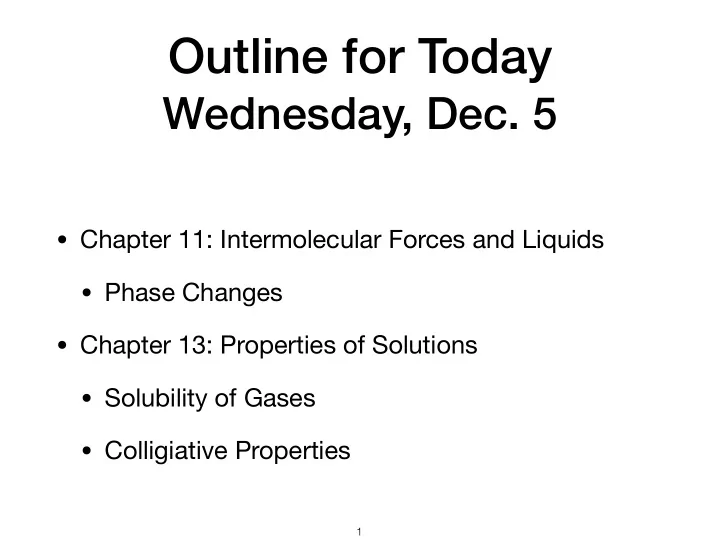

Outline for Today Wednesday, Dec. 5 • Chapter 11: Intermolecular Forces and Liquids • Phase Changes • Chapter 13: Properties of Solutions • Solubility of Gases • Colligiative Properties � 1
Example Problem • Why is methanol (CH 3 OH) miscible in water but hexanol (CH 3 CH 2 CH 2 CH 2 CH 2 CH 2 OH) is not? H H 2 H 2 H 2 H C C C C OH H 3 C C C OH H 2 H 2 H methanol hexanol H H O water
Saturated Solutions • Saturated solution: A solution that is at equilibrium with undissolved solute. Additional solute will not dissolve. dissolve solute + solvent solution crystalize • The rate of dissolving is equal to the rate of crystalizing.
Supersaturated Solutions
Example Problem: Saturated solutions Using the graph, will the addition of 40.0 g of potassium chloride to 100.0 g of water at 80 o C lead to a saturated solution or unsaturated solution?
Solubility of gases • Henry’s Law Solubility of a gas increases directly with increasing pressure More collisions with the surface of the liquid increases dissolving. S g = k P g
Temperature Effects • Solubility of (most) solids increases with increasing temperature. • Solubility of gases decreases with increasing temperature. • Why? • The best answer involves entropy! • Higher the temperature, the higher the kinetic energy of all substances. • The higher the kinetic energy, the more likely for the dissolved gas to escape the solution and become a gas.
Let’s try it!
Units of Concentration Moles of Solute • Molarity (M) = Liters of Solution Moles of Solute • Molality (m) = Kilograms of Solvent Moles of Solute • Mole Fraction (X) = Total Moles
Units of Concentration mass of solute • Mass Percent = x 100 total mass of solution mass of solute • parts per million (ppm) = x 10 6 total mass of solution mass of solute • parts per billion (ppb) = x 10 9 total mass of solution
Colligative Properties Depend on the Concentration (not identity) of Solute Particles • The lowering of Vapor Pressure depends on the mole fraction of the solvent . • The increase of Osmotic Pressure increase depends on the molarity (M) of the ions . • Freezing Point Depression depends on molality (m) • Boiling Point Elevation depends on molality (m) .
Vapor Pressure • Vapor Pressure Lowering depends on mole fraction. • Raoult’s Law:
Osmotic Pressure • Osmotic Pressure: Net movement of solvent (water) from low concentration areas to high concentration areas across a semipermeable membrane.
Osmotic Pressure • Osmotic Pressure increases as MOLARITY increases
Boiling Point Elevation Pure Solvent Solution
Boiling Point Elevation Pure Solvent Solution ∆ T b =T b (solution)-T b (pure solvent) = iK b m
Freezing Point Depression Solution Pure Solvent
Freezing Point Depression Solution Pure Solvent ∆ T f =T f (solution)-T f (pure solvent) = iK f m
Example Problem: Freezing Point Depression • Below is a table of van’t Ho ff Factors (K b and K f ) but water is missing! • What is K b if the freezing point of 500.0 g of water with 25.0 g of calcium chloride dissolved in it is 2.5 o C? ∆ T f =T f (solution)-T f (pure solvent) = iK f m
Example Problem: Boiling Point Elevation • How many grams of salt (NaCl) would you have to add to 2.0 kg of pasta water to raise the boiling point 5 o C? ∆ T b =T b (solution)-T b (pure solvent) = iK b m • 1 tablespoon of NaCl is 25 g. How many tablespoons is that?
Example Problem: Osmotic Pressure • What molarity of sodium chloride would a solution have to be to have an osmotic pressure equal to the osmotic pressure of blood which is 7.7 atm at 25 o C?
Example Problem: Vapor Pressure • Sort the following by increasing vapor pressure of water: • A) A solution 10.0 g of glucose (C 6 H 12 O 6 ) • B) A solution of 10.0 g of sucrose (C 12 H 22 O 11 ) • C) A solution of 10.0 g of methanol (CH 3 OH)
Recommend
More recommend